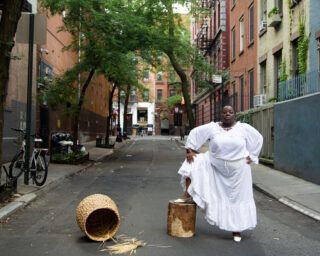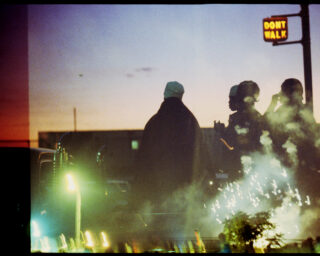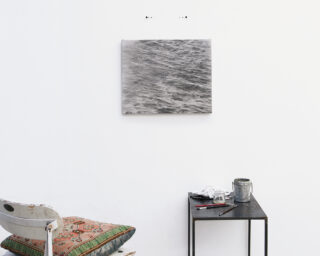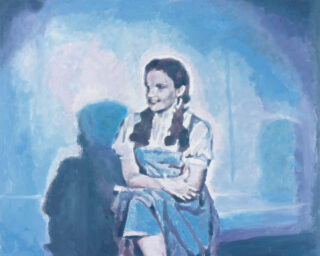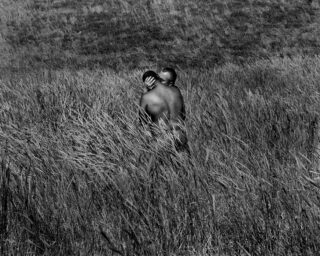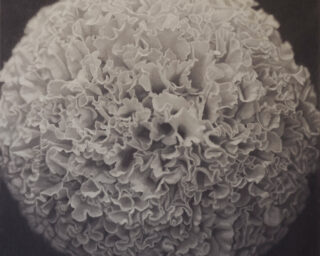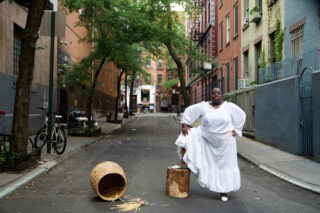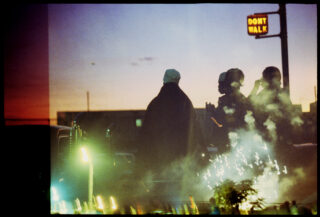How Should a Mother Be?

Charlie Engman, Mom in the Yellow Suburbs, 2016
Courtesy the artist
What is a grown man supposed to do with his mother? Ignore her. Help her. Visit her dutifully. Keep an emotional and intellectual distance. Bring the grandchildren around to show. Suffer with a plastic smile through Thanksgiving dinners. Keep the thick and invisible wall between grown child and mature parent in its place.

Charlie Engman, Mom in Purple, 2016
Courtesy the artist
To do anything else is a taboo that we do not even talk about. But the heart-stopping fear and wonder and sometimes disgust that Charlie Engman’s portraits of his mother engender in the viewer make this taboo plain. To make art with someone else (as Engman and his mother make these photographs together) is always to engage in an intimate exchange of mind, body, spirit, heart. Why should it be so shocking to see this intimacy happen between a grown man and his mother? If a man sees his mother naked—photographs her naked—the mind reels. It’s not incest, the viewer assures herself, but is it like incest? What sorts of conversations did these two have? It’s not disgust—it’s almost envy. How did this mother-son dyad breach the invisible wall and come to be collaborators? Come to be peers? How did they take on such new (and seemingly free) roles in relation to each other, not the roles prescribed by society—in which the son views his mother with polite forbearance and the mother hides from her child the truth of her aging body (at the very least!)—but something radical they invented in common? The photographs do not answer these questions, but these questions hang in their atmosphere. There is something proud in these photographs—something of the Nietzschean Übermensch. There is also something abject—to abjure the roles that others play is both heroic and abject. That is how these pictures seem. That is how this mother seems.

Charlie Engman, Mom with Brace, 2016
Courtesy the artist
But it is not only that the model is the photographer’s mother that chips away at our conventional sensibilities; it is also that the female model is old. It’s hardly worth saying that the desire of men (and of many women) to look at a woman is most often the desire to look at a young woman. Looking at a young woman is natural, because on some level the (male) looker is looking in order to assess her fertility: there is something wholesome about it. Sure, it is about lust, but that lust is about adding to the human population. Looking at an older woman cannot fit into that equation so snugly. It cannot be as simply explained. If looking at a young woman is natural, looking at an old woman is perverse. No one would argue this. We don’t believe it. And yet that is in these pictures, too.

Charlie Engman, Mom on Rocks, 2014
Courtesy the artist
Also, a mother is supposed to tell her son what to do. A son is not supposed to tell his mother what to do. But even though these two are collaborators in their art, if the viewer doesn’t know this, we credit the photographer with the inevitable power any artist has over their subject, and so, in these pictures, there is a quality of sadism, or at least of revenge: the son orders the mother around now. Finally the child has the upper hand!

Charlie Engman, Mom (detail), 2014
Courtesy the artist
Yet you can’t help but notice, looking at this woman’s face, that she is strong. She is magnetic. She has something deep and compelling inside her. She is not a mere tool of her child’s will. What if she is the artist, and her son is the tool? To dwell on this idea while looking at these pictures is very gratifying.

Charlie Engman, Mom in the Snow, 2012
Courtesy the artist
But that is not where we can end. We must accept that they are both the artist, and that they made these images together, because that is the truth. Which brings us back to their Thanksgiving dinner—achingly, unimaginably unlike our own! Or else, just like our own. Perhaps only in front of and behind the lens, only in the making of art (as is the case with every artist), are this mother and son so free.
Sheila Heti is the author several books, including How Should a Person Be? (2010) and Motherhood (2018).
Read more from Aperture, issue 233, “Family.”












